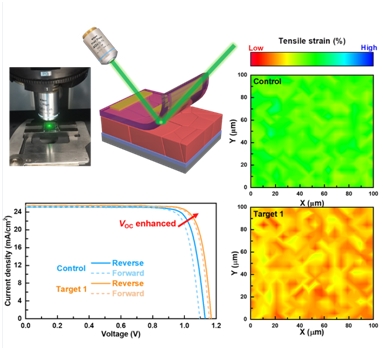The significant impact of stress induced by thermal expansion coefficient mismatch on the photovoltaic performance and stability of perovskite cells has been confirmed, making it crucial to effectively describe the stress distribution in perovskite thin films and their variations. Currently, X-ray diffraction (XRD) techniques are widely used to determine stress variations.
However, the neglect of in-plane stress induced by the Poisson effect makes accurately measuring the spatial stress distribution using XRD a significant challenge. Additionally, XRD techniques with "single-point" testing mode characteristics cannot effectively differentiate between stress differences at grain boundaries and within grain interiors in perovskite thin films.
In a study published in Joule, the team led by Prof. GAO Peng at Fujian Institute of Research on the Structure of Matter of the Chinese Academy of Sciences, realized enhanced photovoltaic efficiency and scalability through uniform spatial stress distribution in perovskite thin film devices.
The researchers introduced confocal micro-Raman spectroscopy (CMRS) mapping as a powerful supplement to traditional XRD for characterizing spatial stress in perovskite thin films, effectively reflecting the uniformity of their stress distribution. They demonstrated that non-uniform nucleation processes driven by surface free energy affect the crystal stacking of perovskite thin films, leading to variations in spatial strain distribution.
Perovskite thin films prepared on suitable surface free energy substrates exhibit uniform spatial stress distribution, which corresponds to the suppression of non-radiative recombination within the device and enhanced interface carrier extraction capability. Photovoltaic cells based on a 1.57 eV bandgap perovskite system achieve a photovoltaic conversion efficiency of 24.64%, one of the highest reported values to date (close to 80% of the Shockley–Queisser limit).
The uniform spatial stress distribution significantly improves the stability of the devices, with devices maintaining 86% of their initial efficiency after 350 hours of maximum-power-point tracking (MPPT) aging based on the international summit on organic pv stability (ISOS-L-1) protocol.
This study emphasizes the importance of a comprehensive assessment of the spatial strain uniformity to approach efficient and stable perovskite photovoltaics, which is important for ensuring the stability and commercial viability of perovskite photovoltaics.

Illustration of the Research (Image by Prof. GAO’s Group)
Contact:
Prof. GAO Peng
Fujian Institute of Research on the Structure of Matter
Chinese Academy of Sciences
Email: peng.gao@fjirsm.ac.cn